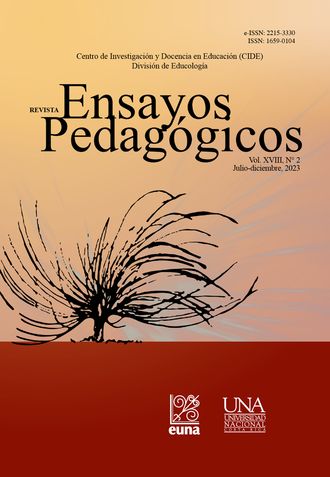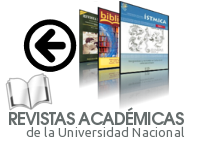Somatic Education and its Relationship with Ballet Learning for Contemporary Dance Dancers: Psychopedagogical Principles for Self-regulated Learning in Artistic Expression
DOI:
https://doi.org/10.15359/rep.18-2.13Keywords:
autonomy, education, ballet, learning, self-regulation, somatic educationAbstract
In this article, the principles of somatic education and their relationship with ballet instruction for contemporary dance dancers are elucidated. Simultaneously, psychopedagogical guidelines are proposed to foster self-regulation and learning autonomy in artistic expression. The article concludes with the development of a didactic sequence model aimed at ballet instruction for contemporary dance dancers, progressively promoting self-regulation and learning autonomy within this discipline.
References
Bales, M. y Nettl-Fiol, R. (2008). The body eclectic: Evolving practices in dance training. University of Illinois Press.
Barragán, R. (2007). El eterno aprendizaje del soma: análisis de la educación somática y la comunicación en la danza. Cuadernos de Música, Artes Visuales y Artes Escénicas, 3(1), 105-159. https://revistas.javeriana.edu.co/index.php/cma/article/view/6442
Berg, T. (2017). Ballet as Somatic Practice: A Case Study Exploring the Integration of Somatic Practices in Ballet Pedagogy. Journal of Dance Education, 17(4), 147-157. https://doi.org/10.1080/15290824.2017.1310382
Bleeker, M. (2014). Merchants or Maths? Thinking Bodies and Dancing Selves. En D. Brown y M. Vos (eds.), Ballet, Why and how? (pp. 69-80). ArtEZ Press.
Colomina, R., Onrubia, J., y Rochera, M. J. (2014). Interactividad, mecanismos de influencia educativa y construcción del conocimiento en el aula. En C. Coll, J. Palacios y A. Marchesi (comps.), Desarrollo Psicológico y Educación 2. Psicología de la educación escolar (pp. 437-458). Alianza Editorial.
Dyer, B. (2009). Merging Traditional Technique Vocabularies with Democratic Teaching Perspectives in Dance Education: A Consideration of Aesthetic Values and Their Sociopolitical Contexts. The Journal of Aesthetic Education, 43(4), 108-123. http://www.jstor.org/stable/25656251
Eddy, M. H. (2009). A brief history of somatic practices and dance: historical development of the field of somatic education and its relationship to dance. Journal of Dance & Somatic Practices, 1, 5-27. https://doi.org/10.1386/jdsp.1.1.5_1
Escudero, M. C. (2007). Disciplina y cuerpo: el ejemplo de la danza clásica. IV Jornadas de Jóvenes Investigadores. Instituto de Investigaciones Gino Germani, Facultad de Ciencias Sociales, Universidad de Buenos Aires, Buenos Aires. https://www.aacademica.org/000-024/155.pdf
Feldenkrais, M. (1985). Autoconciencia por el movimiento. Paidós.
Flavell, J. H., Miller, P. H. y Miller, S. A. (2002). Desarrollo cognitivo. Pearson Education.
Foucault, M. (2002). Vigilar y castigar: nacimiento de la prisión (1.ª Ed.). Siglo XXI Editores.
Green, J. (1999). Somatic authority and the myth of the ideal body in danceeducation. Dance Research Journal, 31(2), 80-100. https://doi.org/10.2307/1478333
Hanna, T. (1986). What is Somatics. Clinical Somatics. https://somatics.org/library/htl-wis1
Hanna, T. (2018). Conciencia Corporal. Recuperar el Control de la Mente sobre el Movimiento, la Flexibilidad y la Salud. Ediciones ANASUYA.
Isiguen, A. (2015). Sensing and Shaping from Within: Exploring the Integration of Somatic Concepts into the Teaching and Learning of Ballet [Tesis de maestría, Universidad de California]. Escholarship. https://escholarship.org/uc/item/0sh0s4sp
International Somatic Movement Education and Therapy Association (ISMETA). (2023). ISMETA affiliated professional organization. https://ismeta.org/professional-membership-organizations#!directory
Jackson, J. (2005). My dance and the ideal body: Looking at ballet practice from the inside out. Research in Dance Education, 6(1-2), 25-40. https://doi.org/10.1080/14617890500373089
Johnson, L. (2011). More than skin deep: The enduring practice of ballet in universities. Theatre, Dance and Performance Training, 2(2), 181-197. https://doi.org/10.1080/19443927.2011.603350
Kirschner, F., Paas, F. y Kirschner, P. A. (2009). Individual and group-based learning from complex cognitive tasks: Effects on retention and transfer efficiency. Computers in Human Behavior, 25(2), 306-314. https://doi.org/10.1016/j.chb.2008.12.008
Lakes, R. (2005). The Messages behind the Methods: The Authoritarian Pedagogical Legacy in Western Concert Dance Technique Training and Rehearsals. Arts Education Policy Review, 106(5), 3-20. https://doi.org/10.3200/AEPR.106.5.3-20
Monereo, C. (2001). La enseñanza estratégica: enseñar para la autonomía. En C. Monereo (coord.), Ser estratégico y autónomo aprendiendo (pp. 11-27). Graó.
Morand, F. (2017). En torno a conceptos generales que definen la Somática. A.Dnz, 2, 230-235. https://adnz.uchile.cl/index.php/ADNZ/article/view/45074
Nordin-Bates, S. (2014). Dancing under the Weight of Pre-Conceived Ideas?. En D. Brown y M. Vos (eds.), Ballet, Why and how? (pp. 69-80). ArtEZ Press.
Paris, S. G. y Paris, A. H. (2001). Classroom applications of research on self-regulated learning. Educational Psychologist, 36(2), 89-101. https://doi.org/10.1207/S15326985EP3602_4
Pintrich, P. R. y De Groot, E. V. (1990). Motivation and self-regulated learning components of classroom academic performance. Journal of Educational Psychology, 82(1), 33-40. https://psycnet.apa.org/doi/10.1037/0022-0663.82.1.33
Pintrich, P. R. (2000). The role of goal orientation in self-regulated learning. En M. Boekaerts, P. R. Pintrich y M. Zeidner (eds.), Handbook of self-regulation (pp. 451-502). https://psycnet.apa.org/doi/10.1016/B978-012109890-2/50043-3
Radell, S. A., Keneman, M. L., Adame, D. D. y Cole, S. P. (2014). My body and its reflection: A case study of eight dance students and the mirror in the ballet classroom. Research in Dance Education, 15(2), 161-178. https://doi.org/10.1080/14647893.2013.879256
Sánchez, G. (2015). Aprendizaje entre iguales y aprendizaje cooperativo: principios psicopedagógicos y métodos de enseñanza. Revista Ensayos Pedagógicos, X(1),103-123. https://doi.org/10.15359/rep.10-1.5
SIA-077-18/ SIA-0129-21. Centro de Prevención y preparación para la Danza y las Artes. CEPREDA. Universidad Nacional, Costa Rica.
SIA-0543-18. Proyecto Espacio de investigación en educación somática para el mejoramiento de los procesos pedagógicos en Danza. Universidad Nacional, Costa Rica.
SIA-0266-20. Proyecto de ballet desde la primera persona: un aprendizaje holístico y somático de la Escuela de Danza. Universidad Nacional, Costa Rica.
SIA-0101-22. LAPSO. Universidad Nacional, Costa Rica.
Schunk, D. H. y Zimmerman, B. J. (1997). Social origins of self-regulatory competence. Educational Psychologist, 32(4), 195-208. https://doi.org/10.1207/s15326985ep3204_1
Trías, D. y Huertas, J. A. (2020). Autorregulación en el aprendizaje. Manual para el asesoramiento psicoeducativo. Ediciones Universidad Autónoma de Madrid.
UNA-AS-ED-ACUE-001-2023. Asamblea de Unidad, Escuela de Danza, Universidad Nacional, Costa Rica.
Weidmann, C. (2018). A New Dialogue in Ballet Pedagogy: Improving Learner Self-Sufficiency Through Reflective Methodology. Journal of Dance Education, 18(2), 55-61. https://doi.org/10.1080/15290824.2017.1346798
Zimmerman, B. J. (1989). A social cognitive view of self-regulated academic learning. Journal of Educational Psychology, 81(3), 329-339. https://psycnet.apa.org/doi/10.1037/0022-0663.81.3.329
Zimmerman, B. J. (2008). Investigating self-regulation and motivation: Historical background, methodological developments, and future prospects. American Educational Research Journal, 45(1), 166-183. https://doi.org/10.3102/0002831207312909
Downloads
Published
How to Cite
Issue
Section
License
Copyright (c) 2024 Ensayos Pedagógicos Journal

This work is licensed under a Creative Commons Attribution-NonCommercial-NoDerivatives 4.0 International License.
Ensayos Pedagógicos is subscribed to the Attribution-NonCommertial-NoDerivatives 4.0 International Creative Commons Licence, which allows both authors and readers to freely download, store, copy, and distribute the final approved publisehd version of the manuscript (post-print) as long as this is done without commercial purposes, no derivative works are generated, and the source and author are mentioned. As well, Ensayos Pedagógicos declares that authors will remain the rightful owners of the copyrights of their work in perpetuity.







